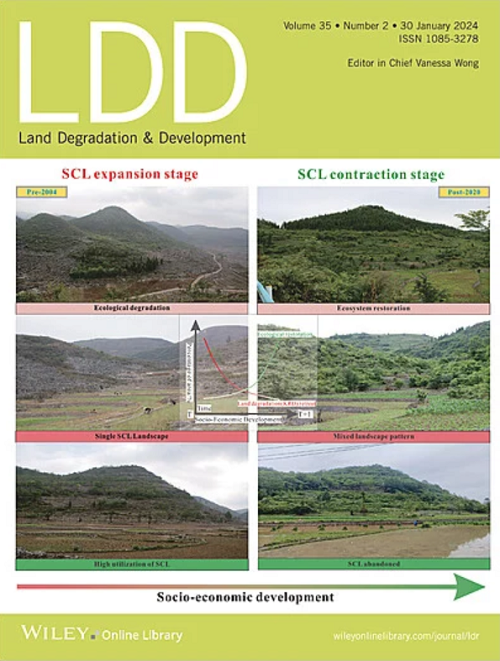Cropping History and Cropland Abandonment Period Influenced Levels of Soil Organic Carbon, Distribution of Aggregates and Aggregate Associated Carbon
IF 3.6
2区 农林科学
Q2 ENVIRONMENTAL SCIENCES
引用次数: 0
Abstract
Knowledge gaps remain regarding soil organic carbon (SOC) storage and aggregate dynamics under varying cropland abandonment periods, particularly within the context of degraded and low-SOC soils. This study aimed to assess the influence of cropping history and the period of cropland abandonment period on SOC, aggregate distribution, and aggregate associated carbon in the Eastern Cape, South Africa. Two abandoned cropland sites, namely 2 LUC (abandoned since 2021) and 6 LUC (abandoned since 2017), were examined. Soil samples were collected at depth intervals of 0–10 cm, 10–20 cm, and 20–30 cm. The samples were analyzed for soil texture, pH, organic carbon, humic and fulvic acids, exchangeable Ca, Mg, and K, wet and dry aggregate distribution, mean weight diameter (MWD), and aggregate associated organic carbon. Dry and water stable microaggregates plus individual particles dominated in 2 LUC, while 6 LUC showed an even distribution of large and small macroaggregates, along with microaggregates plus individual particles. Wet and dry MWD were significantly higher in 6 LUC across all depths. Macroaggregate associated organic carbon did not differ significantly between the sites and depths, whereas microaggregate associated organic carbon was consistent between sites but decreased with depth from 0–10 cm to 10–20 cm. The results highlight the complex interaction between soil structure, aggregate stability, and carbon content, suggesting that a combination of factors such as cropping history, soil disturbance, and biological activity shape aggregate characteristics, in addition to the effects of SOC. Additionally, the duration of cropland abandonment plays a key role in overcoming the legacy effects of prior land use.种植历史和退耕期影响土壤有机碳水平、团聚体和团聚体伴生碳的分布
关于不同耕地弃耕期下土壤有机碳(SOC)的储存和聚集动态,尤其是在退化和低SOC土壤的背景下,仍然存在知识空白。本研究旨在评估南非东开普省的种植历史和耕地弃耕期对土壤有机碳、团聚体分布和团聚体相关碳的影响。研究考察了两个废弃耕地地点,即 2 LUC(2021 年以来废弃)和 6 LUC(2017 年以来废弃)。土壤样本采集深度为 0-10 厘米、10-20 厘米和 20-30 厘米。对样本进行了土壤质地、pH 值、有机碳、腐殖酸和富勒酸、可交换钙、镁和钾、干湿集料分布、平均重量直径(MWD)和集料相关有机碳分析。在 2 LUC 中,干的和水稳定的微团聚体以及单个颗粒占主导地位,而 6 LUC 则显示出大小宏观团聚体以及微团聚体和单个颗粒的均匀分布。在所有深度上,6 LUC 的干湿分水岭都明显较高。不同地点和深度的大团聚体相关有机碳没有明显差异,而不同地点的微团聚体相关有机碳是一致的,但随着深度从 0-10 厘米到 10-20 厘米的增加而减少。这些结果凸显了土壤结构、团聚体稳定性和碳含量之间复杂的相互作用,表明除了 SOC 的影响外,种植历史、土壤扰动和生物活动等综合因素也会影响团聚体的特征。此外,耕地弃耕时间的长短在克服先前土地利用的遗留影响方面也起着关键作用。
本文章由计算机程序翻译,如有差异,请以英文原文为准。
求助全文
约1分钟内获得全文
求助全文
来源期刊

Land Degradation & Development
农林科学-环境科学
CiteScore
7.70
自引率
8.50%
发文量
379
审稿时长
5.5 months
期刊介绍:
Land Degradation & Development is an international journal which seeks to promote rational study of the recognition, monitoring, control and rehabilitation of degradation in terrestrial environments. The journal focuses on:
- what land degradation is;
- what causes land degradation;
- the impacts of land degradation
- the scale of land degradation;
- the history, current status or future trends of land degradation;
- avoidance, mitigation and control of land degradation;
- remedial actions to rehabilitate or restore degraded land;
- sustainable land management.
 求助内容:
求助内容: 应助结果提醒方式:
应助结果提醒方式:


